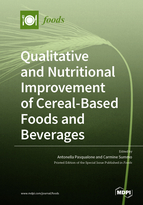Qualitative and Nutritional Improvement of Cereal-Based Foods and Beverages
A special issue of Foods (ISSN 2304-8158). This special issue belongs to the section "Grain".
Deadline for manuscript submissions: closed (30 October 2020) | Viewed by 93587
Special Issue Editors
Interests: cereal science and technology; enrichment of cereal-based foods; ethnic foods; food waste upcycling
Special Issues, Collections and Topics in MDPI journals
Interests: pulses; cereals; food chemistry; food analysis; food technology; food packaging and shelf life
Special Issues, Collections and Topics in MDPI journals
Special Issue Information
Dear Colleagues,
Cereal-based foods and beverages include a wide array of products, varying greatly from one geographic area to another. Increased consumer awareness of the effects of food on health has made nutritional improvement an important goal of the food and beverage industry, including the cereal sector, to ensure compliance with current nutrition and health claims regulations.
This involves different strategies, such as the selection of raw materials, the reformulation of products, the introduction of functional ingredients, the application of mild processing technologies, the use of biotechnological approaches to increase the bioavailability of bioactive compounds, and the development of more effective packaging and conditioning systems.
All of these interventions, however, may alter the physico-chemical and sensory properties of final products, which, in turn, determine their quality. It is therefore necessary to achieve a balance between nutritional and quality modification, which does not exclude the possibility of communicating a “new quality” to consumers.
This Special Issue is therefore open to all contributions aimed at exploring alternative ways to innovate and improve cereal-based foods and beverages, an old—if not ancient—group of products that are still on our table every day.
Prof. Antonella Pasqualone
Dr. Carmine Summo
Guest Editors
Manuscript Submission Information
Manuscripts should be submitted online at www.mdpi.com by registering and logging in to this website. Once you are registered, click here to go to the submission form. Manuscripts can be submitted until the deadline. All submissions that pass pre-check are peer-reviewed. Accepted papers will be published continuously in the journal (as soon as accepted) and will be listed together on the special issue website. Research articles, review articles as well as short communications are invited. For planned papers, a title and short abstract (about 100 words) can be sent to the Editorial Office for announcement on this website.
Submitted manuscripts should not have been published previously, nor be under consideration for publication elsewhere (except conference proceedings papers). All manuscripts are thoroughly refereed through a single-blind peer-review process. A guide for authors and other relevant information for submission of manuscripts is available on the Instructions for Authors page. Foods is an international peer-reviewed open access semimonthly journal published by MDPI.
Please visit the Instructions for Authors page before submitting a manuscript. The Article Processing Charge (APC) for publication in this open access journal is 2900 CHF (Swiss Francs). Submitted papers should be well formatted and use good English. Authors may use MDPI's English editing service prior to publication or during author revisions.
Keywords
- cereals
- essential amino acids
- essential fatty acids
- dietary fiber
- micronutrients
- phytochemicals
- antioxidant activity
- texture
- color
- aroma








